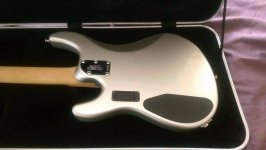srenkin
New member
Hoping you can shed some light on some of the design changes for the EBMM Sterling 4-string bass since the 90's. I had a 1995 Sterling (honeyburst, maple neck) that I should never have sold, but I was on hiatus from live music and didn't really need a pro instrument. I started playing again last year, and bought a Sterling by MM SB14 - nice product, but not quite the same as the real deal. I'm now looking to get back in the game and as I explore new and used Sterlings I find some interesting variations in the placement of the battery, the control cavity coverplate shape, and the neck plate. Specifically:
Battery compartment: on my 95 Sterling, the battery was under a chrome cover next to the control cavity. Obviously, now they use the "pop up" variety, but when did they move the battery compartment to the lower horn?
Control cavity: My 95 Sterling had a cavity that was a shallow "half moon" shape. When did the cavity become larger (there's a "bump" on the side facing the center of the bass)?
Neck plate: My 95 Sterling was routed so the neck plate fit flush against the wood of the bass. When did they stop doing this, and mounting the plate on top of the wood?
Battery compartment: on my 95 Sterling, the battery was under a chrome cover next to the control cavity. Obviously, now they use the "pop up" variety, but when did they move the battery compartment to the lower horn?
Control cavity: My 95 Sterling had a cavity that was a shallow "half moon" shape. When did the cavity become larger (there's a "bump" on the side facing the center of the bass)?
Neck plate: My 95 Sterling was routed so the neck plate fit flush against the wood of the bass. When did they stop doing this, and mounting the plate on top of the wood?



